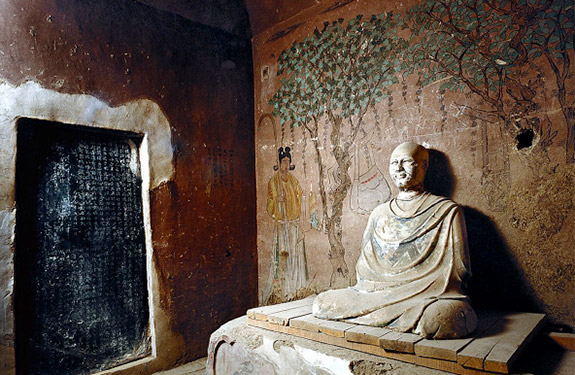Written legacy of Dunhuang Library Cave

The Dunhuang Library Cave was discovered in 1900 and thousands of manuscripts have been excavated.
Since the discovery of the Dunhuang Library Cave in 1900, thousands of ancient manuscripts have been revealed to the public and attracted the attention of many scholars with different disciplinary backgrounds. Due to the specific natural conditions of Dunhuang, Gansu Province, a number of murals, painted sculptures and calligraphy works were well preserved. Excavated Dunhuang calligraphy has enormously contributed to research on the history of ancient Chinese calligraphy, particularly in the Qin, Han, Wei, Jin, Sui and Tang dynasties.
A broad range of calligraphy works were excavated from the site. Most manuscripts excavated from the Dunhuang Library Cave are works of calligraphy. They include Han bamboo slip calligraphy, grotto inscriptions and tablet inscriptions unearthed in ancient sites around the Dunhuang area.
Evolution, styles
Dunhuang manuscripts contain more than 40 thousand volumes of calligraphy from the Jin Dynasty and the Sixteen Kingdoms period to the Northern Song Dynasty. They are the most plentiful and systematic primary sources for modern researchers studying the history and calligraphy art, particularly of the evolution of Chinese characters into the kai style, also known as the standard traditional style. The style of the characters used in the Dunhuang manuscripts, known as the Buddhist text style, has distinctive characteristics of its time and region. The Buddhist text style is derived from the Han bamboo slip style and finally formed the Tang kai style, a significant form of chirography for transcribing Buddhist texts that emerged after the Western and Eastern Jin dynasties. The Buddhist text style is indicative of the whole process of Chinese character evolution and the change into kai style, which boosted the development of Chinese characters.
In the Han Dynasty sites of the Dunhuang area, nearly 17,500 pieces of Han bamboo slips were unearthed. They are significant resources demonstrating the evolution of character styles and calligraphy art in the two Han dynasties.
Handwritings
Three volumes of Dunhuang manuscripts that focus on calligraphy theory draw the bulk of academic attention. One is on calligraphy methods, elaborately introducing the scale of each stroke and the size of each character. The second and the third volumes are copies of the great Jin calligrapher Wang Xizhi’s theory of calligraphy.
The hard brush calligraphy works in the Dunhuang manuscripts are folk creations and are not recorded in Chinese calligraphy history. The hard brush is actually made of wood and reed. Based on the hard brushes excavated in Gansu Province, the brush tip was divided into two sections, which was completely identical to today’s fountain pen nib. This illustrates that China has had hard brush calligraphy since ancient times.
Most of the Dunhuang manuscripts were transcribed by brush and represent the great achievements of ancient folk calligraphy. The hired copyists for the Dunhuang manuscripts were Buddhist text transcribers or ordinary people. They transcribed manuscripts all year round and accumulated artistic skills on calligraphy, and people have expressed admiration for their superb skill.
Moreover, there are precious calligraphy inscriptions on the murals of the 492 caves of the Dunhuang Mogao Grottoes. These inscriptions were written by the painters of the murals. The number of calligraphy inscriptions is huge while the quality is unparalleled. Besides a few excellent works, many inscriptions are mixed with incorrectly written characters.
Various ethnic scripts
Throughout history, the Dunhuang area has been occupied by many ethnic groups, so a variety of manuscripts with ethnic scripts, including Sanskrit, Mongolian, Uighur, Tangut and Tibetan script, have been preserved. The largest proportion is Tibetan manuscripts. These manuscripts were written by ink brush or hard brush in a neat and flowing manner and have a relatively high artistic value.
